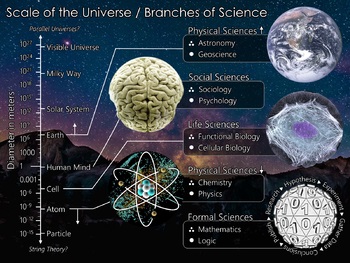|
|
| |
|
|
| |
|
|
|
|
| |
 |
| The scale of the
universe mapped to the branches of science. |
Formal Sciences
Science is what we do to find out about the natural
world. Natural sciences include physics, chemistry,
biology, geology and astronomy. Science uses mathematics
and logic, which are sometimes called "formal sciences".
Natural science makes observations and experiments.
Science produces accurate facts, scientific laws and
theories. 'Science' also refers to the large amount of
knowledge that has been found using this process.
Research uses the scientific method. Scientific research
uses hypotheses based on ideas or earlier knowledge,
which can be categorized through different topics. Then
those hypotheses are tested by experiments.
People who study and research science and try to find
out everything about it are called scientists.
Scientists study things by looking at them very
carefully, by measuring them, and by doing experiments
and tests. Scientists try to explain why things act the
way they do, and predict what will happen. |
|
Scientific
method
Today, "science" usually refers to a way of pursuing
knowledge, not just the knowledge itself. It is mainly
about the phenomena of the material world.
In the 17th and 18th centuries scientists increasingly
sought to formulate knowledge in terms of laws of nature
such as Newton's laws of motion. And over the course of
the 19th century, the word "science" became increasingly
associated with the scientific method itself, as a way
to study the natural world, including physics,
chemistry, geology and biology.
It was in the 19th century also that the term scientist
was created by William Whewell. He meant it to
distinguish those who sought knowledge on nature from
those who sought other types of knowledge.
The scientific method is the name given to the methods
used by scientists to find knowledge. The main features
of the scientific method are: |
- Scientists identify a question or a
problem about nature. Some problems are simple, such as
"how many legs do flies have?" and some are very deep,
such as "why do objects fall to the ground?"
- Next, scientists investigate the
problem. They work at it, collecting facts. Sometimes
all it takes is to look carefully.
- Some questions cannot be answered
directly. Then scientists suggest ideas, and test them
out. They do experiments and collect data.
- Eventually, they figure out what
they think is a good answer to the problem. Then they
tell people about it.
- Later, other scientists may agree or
not agree. They may suggest another answer. They may do
more experiments. Anything in science might be revised
if we find out the previous solution was not good
enough.
|
|
An
example
A famous example of science in action was the expedition
led by Arthur Eddington to Principe Island in Africa in
1919.
He went there to record the positions of stars around
the Sun during a solar eclipse. The observation of star
positions showed that the apparent star positions close
to the Sun were changed. In effect, the light passing
the Sun was pulled towards the Sun by gravitation. This
confirmed predictions of gravitational lensing made by
Albert Einstein in the general theory of relativity,
published in 1915.
Eddington's observations were considered to be the first
solid evidence in favour of Einstein's theory. Had the
observations resulted differently, this would have
counted against Einstein's theory, and perhaps refuted
it (shown it was wrong).
Other
features of science
Not everyone completely agrees about how science works.
Some philosophers and scientists say that scientific
theories are only accepted for the time being. They last
so long as they are the best explanation. When theories
no longer explain the data, they are discarded and
replaced. Or, sometimes scientists will make a theory
better rather than discard it, or they will keep on
using the theory hoping that it will be made better
eventually.
Science is a way to get knowledge by discarding what is
not true.
Scientists must be very careful to make explanations
that fit well with what they observe and measure. They
compete to provide better explanations. An explanation
might be interesting or pleasing, but if it does not
agree with what other scientists really see and measure,
they will try to find a better explanation.
Before a scientific article is published, other
scientists read the article and decide whether the
explanations make sense from the data. This is called
peer review. After articles are published, other
scientists will also check if the same experiments,
observations or tests produce the same data again. Peer
review and repeating experiments are the only way to be
sure the knowledge is correct.
Science makes models of nature, models of our universe,
and medicine. There are many different sciences with
their own names. However it is not right to say "science
says" any one thing. Science is a process, not just the
facts and rules believed at one time. |
|
|
|
|
|
|
|
|
|
|
|
|
|
|
|
|
|
|
Search Fun Easy English |
|
|
|
|
|
|
|
|
|
|
|
|
|
|
|
About
Contact
Copyright
Resources
Site Map |